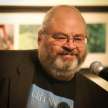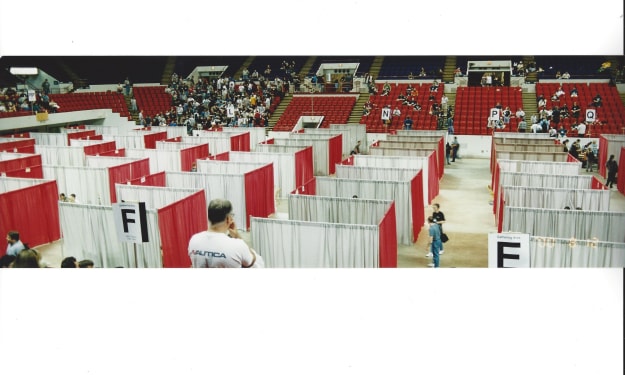Did I Play in the First Roleplaying Game EVER?
No, E. Gary Gygax Was Not Involved

Despite the fact that I have attended GenCon for more years than you have probably been alive and that I was the world’s top-ranked player of Classic RPGA tournaments for fifteen years (1985-2000), I’ve never really thought of myself as an early player of Dungeons & Dragons and, by extension, modern roleplaying games. After all, my first Dungeons & Dragons experience was in a camper in the parking lot of University of Wisconsin Parkside the night before GenCon XII in 1979, after I had already graduated from law school. And I had passed by a few groups playing the game during my college and law school years. So, while I was not at the leading edge of first players, I just tried to do my best playing classic tournaments, playing around 600 different characters in 460 tournaments in a wide variety of different game systems and settings, and winning 235 of those tournaments.
My college history in parliamentary debate (where the affirmative/government team sets the debate anywhere they choose in time and space and, therefore, can be considered a roleplaying type of debate) set me up for my roleplaying and, later, writing, career. But it was when I was writing my story “Second Banana Republic” for Sarah Hans’ Sidekicks!, which is inspired by an event from my high school days, that I realized I may have actually played the first modern roleplaying game ever … predating the publication of the Original D&D by several years.
High schools, especially Social Science classes, are, of course, well known for their historical simulation events: The Continental Congress, Mock United Nations, etc. But I’m not talking about that kind of thing. I’m talking about something that had all the elements we all know and love about roleplaying games.
What’s my definition of a roleplaying game? A game in which each person playing plays a fictional, individual person (not a historical figure or a nation or an army) with a pre-established personality, skills, and items, interacting improvisationally with other fictional, individual persons similarly established who are played by other people, in a setting where events occur at pre-ordained times and places in order to prompt interaction, and where there are items and rules which govern non-verbal actions like fighting/attacks, etc., all moderated by a person who isn’t playing the game.
Historical simulations don’t fit this definition. Neither do strategy, war, or board games. Military simulations can come closer, but are generally based on historical figures or unit operations.
So, what was the game I played?
I was in a Social Sciences class at Naperville Central High School (formerly Naperville Community High School) in Illinois. My best guess is that it was 1971 or spring of 1972, but it might have been a year or so earlier. The class was taught by Mr. Stephens, but he had an aspiring student teacher whose name I can no longer remember (one classmate says it was Mr. Dilley (spelling?), but I have no idea if that is right).
In any event, this student teacher had to do a special project of some sort for his classwork, so he created a simulation-type game, except that it wasn’t a historical simulation, it was a game based on a fictional South American country run by a dictator, except that the dictator had a personality description–all of the characters had personality descriptions and indications of what they thought of the other characters. One for every kid in the class. Mrs. Olson was the owner of a coffee plantation. The dictator’s wife, Boom-Boom, was having affairs with a significant percentage of the male characters (and a minority of the female characters). The Archbishop had an illegitimate kid. The natives smoked peyote in the mountains, and on and on and on. Some of this information was not public, but some of the private information had been gathered by the dictator’s brother and kept in a little black book. The characters had “influence” scores that could be combined to overthrow the dictator (but if their entry from the little black book was read out loud, their influence was cut in half.)
Desks were re-arranged to represent various locations in the country (marked with little folded index card tents with the name of the location), some with special rules (e.g., you couldn’t attack in the sanctuary of the cathedral, unless you were a member of the clergy, etc.) and there were slips of paper representing various kinds of weapons/attack (poison, gun, knife, etc.) and various defensive slips. You just had to hand someone an appropriate slip for combat to occur.
I helped a bit on some of the character stuff, for which I got to pick the character I wanted. (I picked the dictator’s brother, the guy with the little black book.)
The day of the big game some representatives of the student teacher’s college came to watch his big project unfold. Events were announced and player characters reacted improvisationally. I quickly overthrew my brother by way of assassination in collaboration with Boom-Boom, but the masses were against me, so I plotted an escape. First off, I decided to read the entire black book, so to halve the influence against me.
The student teacher blushed as I began to read about all of the scandals and affairs in the book, telling me I could just skip the reading and he would adjust the scores, but I insisted on reading it all aloud. This, of course, incensed my opponents and caused a few raised eyebrows among the college officials. While I had a lot of defensive slips, I knew I was more likely to be killed than overthrown and none of the limited sanctuaries (the cathedral, the mountains, etc.) was safe from all my opponents. So I made up a tent that said Switzerland and surreptitiously dropped it on the teacher’s desk. When it was announced that the United States had delivered millions in foreign aid to the central bank, I went there and stole the funds (giving most of my defensive slips to the bankers as a bribe), then jumped up on the desk for the bank and leapt from desk to desk across the room while the crowd surged toward me to deliver attack slips. I arrived on the teacher’s desk with only one attack having been successfully delivered (for which I had one “good for any attack” defense slip), grabbed the tent and claimed sanctuary in Switzerland.
A raucous good time and, I would say, a genuine roleplaying game experience. Interaction with player characters, pre-ordained events by time and space, combat items, attacks, and events occurring that the gamemaster never, ever planned for.
This scenario could never be played in a high school today. But it inspired a story more than forty years afterwards.
Happy to hear your thoughts on whether this was a true roleplaying experience or not. Also happy for any leads on that student teacher, if you know him and/or could find him, because I would love to get a copy of that scenario.
About the Creator
Donald J. Bingle
Donald J. Bingle is the author of eight books and more than sixty shorter works in the thriller, science fiction, fantasy, horror, mystery, steampunk, comedy, and memoir genres. More on Don can be found at www.donaldjbingle.com.






Comments (2)
What you did sounds a lot like the Braunstein games run by David Wesely and Dave Arneson (as Kevin McColl noted already) in the 1960's and one of these was actually around a fictional Latin-American republic, which sounds a lot like the scenario you experienced. I would guess that your student teacher was probably exposed to that adventure and brought the experience into your classroom. As to whether the Braunstein-style game counts as a "role playing game" or not, well that's probably a debate which will never be resolved. Braunstein had players "play a role" but not mechanically as developed as Arneson's Blackmoor or (later) Dungeons & Dragons. We all did "cops and robbers" or "cowboys and indians" as kids, which required us to play roles, but I'm not sure one would classify this as a "role playing game." Anyway, an enjoyable read. :-)
David Wesely was doing role-playing games at the end of the 60s. He also was a major inspiration for Dave Arneson… Who shortly there after started doing his Blackmoor RPG campaign… who then later approached Gary Gygax and demonstrated the game hoping to get it published. So no #secretsofblackmoor https://www.secretsofblackmoor.com/ A lot of people were experimenting with role-playing long before even David Wesely. But the addition of game mechanics to the art and activity where unique to him as the first roughly around 1967 through to the 1969. gave Arneson was there the entire time. I highly recommend you watch the movie I linked above. As a friend of Dave Arneson and David Wesely I have had some unique access to the original material and conversations